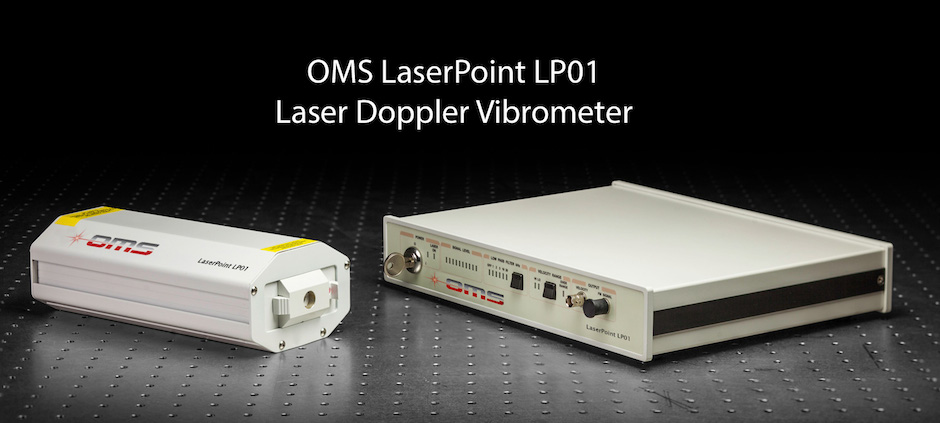
OMS LaserPoint LP01 Laser Vibrometer FAQ
- What does the system measure?
- Can it also measure displacement and acceleration?
- How would I know if the specs of the LaserPoint meet my measurement requirements?
- Do I need to focus the laser beam to each target distance?
- What options do you offer to measure "hard to see" surfaces?
- Can the LaserPoint measure vibration frequencies that are larger than 20 kHz?
- Can I test a LaserPoint to make sure that it meets my measurement needs?
- How long can I rent a LaserPoint?
- Can the LaserPoint tolerate changes in signal amplitude, which may occur when particles or other obscurants block the laser beam?
- Is the laser light visible?
- What is the Safety laser class?
- Do I need to mount the system on a stable table?
- How much training is required to operate the LaserPoint?
- How does the user view the LaserPoint output signal?
- What accessories does OMS offer for the LaserPoint?
1. What does the system measure?
The OMS LaserPoint LP01 measures the velocity and frequency of vibration at a point on a vibrating target. One of the LaserPoint output signals is the velocity of the target measured over time.
2. Can it also measure displacement and acceleration?
Yes. Both of these parameters can be obtained in software by direct integration and derivation of the velocity.
3. How would I know if the specs of the LaserPoint meet my measurement requirements?
Please feel free to contact OMS to discuss your requirements in more detail. In general, there are three parameters that define the measurement:
- Distance to target - For most targets, the standard working distance for the LaserPoint LP01 is from 0 to 5 meters. However, this range can vary based on the scattering properties of the surface to be measured.
- Frequency of vibration - Our standard system can measure frequencies from DC to 20 kHz. However, OMS can provide custom solutions if your application requires frequencies up to 80 kHz - please contact us.
- Velocity of vibration - Our standard system can measure a maximum velocity of 0.8 m/s. The velocity can be calculated as follows: V = 2π * amplitude * frequency. For example if the displacement amplitude is 10 microns and the frequency of vibration is 1 kHz, then the velocity would be 0.063 m/s.
4. Do I need to focus the laser beam to each target distance?
No. The OMS LaserPoint LP01 uses a collimated beam and does not require a focusing lens, therefore it is easy to change the target distance anywhere in the range between 1 cm and 5 meters.
5. What options do you offer to measure "hard to see" surfaces?
One option is to treat the surface with white tape, paint, or powder. Please contact OMS to discuss other options to deal with difficult targets.
6. Can the LaserPoint measure vibration frequencies that are larger than 20 kHz?
Yes. Options are available to use the OMS LaserPoint LP01 at frequencies up to 80 kHz.
7. Can I test a LaserPoint to make sure that it meets my measurement needs?
Yes, we offer very affordable rental options.
8. How long can I rent a LaserPoint?
We offer attractive 1-week terms and you can rent a system for many weeks. Please check with our sales department.
9. Can the LaserPoint tolerate changes in signal amplitude, which may occur when particles or other obscurants block the laser beam?
Yes. The OMS LaserPoint LP01 measures optical phase changes due to target vibration. This optical phase change is manifested as a frequency modulated signal upon mixing the target signal with the reference beam local oscillator. Thus signal amplitude fluctuations will have very little effect on the signal frequency provided that the amplitude of the signal stays above a reasonable threshold. If the signal amplitude falls below the threshold then the instrument will experience a "dropout". The LaserPoint software will look at regions between dropouts and report the valid data.
10. Is the laser light visible?
There are actually two lasers in the OMS LaserPoint LP01. The laser making the measurement is a near-infrared 780nm laser. While this beam can be seen, it is quite dim for most users. The second laser is a red 650nm laser that can be turned on or off by a switch on the back of the laser head. This red laser travels parallel to the infrared beam, making it easier to aim the system.
11. What is the Safety laser class?
The infrared laser is class 3B. The total infrared laser power out of the LaserPoint is less than 20 mW at a wavelength of 780 nm. The red laser is class 2 and has less than 1mW of 650nm laser light.
12. Do I need to mount the system on a stable table?
No. In most applications the system may be mounted on a tripod.
13. How much training is required to operate the LaserPoint?
Most customers are able to operate the system within minutes after receiving it just by following some simple instructions. The system is a plug and play device.
14. How does the user view the LaserPoint output signal?
The output signal can be viewed on an oscilloscope, a spectrum analyzer, or can be digitized with a computer data acquisition system. OMS offers data acquisition boards and software for acquiring, analyzing, and displaying the data.
15. What accessories does OMS offer for the LaserPoint?
OMS offers a rugged three-axis tripod, a data acquisition board, and signal processing software.
